DACH Quality Management System (QMS) Market By Component (Solution, Services (Professional Services, Training and Support, Others)); By Deployment Mode (Cloud Based, On-Premise); By Organization Size (Small and Medium Sized Enterprises, Large Enterprises); By Industry Vertical (Manufacturing, IT, Aerospace, Automotive, Pharmaceutical, Medical Devices, Food and Beverages, Blood, Biologics, and Tissue, Dietary Supplements, Consumer Goods, Others) By Region (Germany, Austria, Switzerland) – Global Insights, Growth, Size, Comparative Analysis, Trends and Forecast, 2019 – 2027
Industry Trends
Quality management system refers to policies, procedures and processes involved in planning and execution of core businesses across an organization. These systems integrate with exiting internal processes to identify, measure, control and improve other systems in the enterprises thereby, enhancing the overall business performance. The quality management solutions are thus adopted across a wide range of industries such as manufacturing, information technology (IT), aerospace, automotive, pharmaceutical, medical devices, food and beverages, blood, biologics and tissue, dietary supplements, and consumer goods amongst other. Digitalization across industries and organizations is driving the growth of DACH quality management system (QMS) market. The constant strategic initiatives being undertaken by businesses to expand geographically is making it difficult for companies to maintain paper documents. Moreover, the shift of sustainable management techniques is also influencing the adoption of quality management solutions across the countries. The outbreak of the covid-19 pandemic is expected to positively impact the growth of the DACH quality management system (QMS) market. This growth is attributed to the increasing need for quality assurance among industries due to the outbreak of the virus. For instance, Food and Drug Administration have announced the increase in off-site audits to reduce the infection risk. The market participants in the DACH quality management system (QMS) market are also developing solutions to capitalize on the prevalent opportunity. For instance, Qualio, which offers QMS solutions for life sciences, introduced a high quality life-saving product for quality management and regulatory compliance for its clients in March 2020. Thus, the increase in adoption of quality management solutions owing to compliance standards for restricting the spread of the virus is expected to showcase sustained growth of the market across the DACH region over the forecast period.
Component Outlook:
DACH quality management system (QMS) market based on component is bifurcated into solutions and services. The services segment is further bifurcated into professional services, and training and support services amongst others. In 2019, the solution segment accounted for the highest share in the market. This growth is attributed to the increase in adoption of varied quality management solutions such as document management, risk management, audits and inspection management, supplier management, equipment and asset management and CAPA complaint and incident management amongst others. Thus, the rising adoption of these solutions for legal standard maintenance and operation optimization is contributing to the growth of the market. The services segment is expected to register the highest CAGR over the forecast period. The integration of advanced technologies in the quality management solutions is rising the demand for professional services, such as consultancy services and software upgradation services for optimum utilization of the system across the end users. For instance, Omnex Inc., offers consulting services with respect to its quality management systems for building customer centric strategic performance objective and improving the overall performance of its clients.
Organization Size Outlook:
DACH quality management system (QMS) market based on organization is bifurcated into small and medium sized enterprises and large enterprises. In 2019, large enterprises accounted for the highest share in the market. Growing globalization initiatives across the industries in DACH countries to expand their businesses across the region, is accompanied with increasing production capacity of the companies coupled with larger customer base. This is fuelling the demand for quality management across large organizations to maintain quality across all production units and thereby increase customer satisfaction. On the other hand, small and medium enterprises are expected to register highest CAGR over the forecast period. DACH countries have experienced a rise in small and medium sized enterprises, as the start-up ecosystem across countries like Germany have attracted investments from huge venture capitalist for strategic growth over the years. For instance, according to studies, the German start-up organization raised capital worth Euro 6.2 Bn in 2019, which recorded an increase of 36% compared to 2018. Thus, the rise in small and medium enterprises across the countries is expected to influence the adoption of quality management systems enabling businesses to offer high quality product to their customers and reduce overall operational cost, thereby, contributing to the growth of the DACH quality management systems market over the forecast period.
Industry Vertical Outlook:
The industry vertical segment of the DACH quality management system (QMS) market is classified into manufacturing, information technology, aerospace, automotive, pharmaceutical, medical devices, food and beverages, blood, biologics and tissue, dietary supplements, and consumer goods amongst others. In 2019, the manufacturing segment recorded the highest share in the market and is also expected to grow with the highest CAGR over the forecast period. Rising government compliance for standardization of manufactured products across the DACH countries is influencing the adoption of quality management systems by the manufacturing companies. For instance, German Federal Institute for Occupational Safety and Health (Baua) in 2020 announced the updated production standards and technical specifications laid down by Product Safety Commission (AfPS) in accordance to the German Product Safety Law – ProdSG with regards to ensuring product quality and safety across industries. These safety and quality assurance requirement by the government is influencing the adoption of quality management systems across manufacturing units in the country. According to studies, the implementation of quality management systems in manufacturing units have enabled the companies to increase their ROI by 300%, which has further aided them to enhance their brand value and gather a larger consumer base. Favourable government initiatives in the regions is anticipated to influence the growth of manufacturing segment in the DACH quality management system (QMS) market over the forecast period.
Region Outlook:
In terms of region, Germany accounted for the highest share in the DACH quality management system (QMS) market and is also expected to register highest CGAR over the forecast period. The significant presence of automotive companies across the country has contributed to the wide scale demand and adoption of these solutions. For instance, according to Germany Trade & Invest Agency in 2019, the total number of passenger car manufactured in the country was 4.6 Mn units. The quality management compliance standards for the manufacturing of automotive is contributing and is also expected to influence the growing adoption of quality management system across the country. The International Automotive Task Force (IATF) has outlined quality management standards across the automotive industry regarding optimizing production quality, reducing waste in supply chain, automotive safety guidelines, and OEM requirements amongst others. Hence, the rapid expansion of the automotive industry in the region is expected further proliferate the growth of DACH quality management system (QMS) market over the forecast period.
In terms of revenue, DACH quality management system (QMS) market was valued at US$ 719.40 Mn in 2019 and is anticipated to reach US$ 1943.63 Mn in 2028, growing at a CAGR of 11.6% over the forecast period. The study analyses the market in terms of revenue across all the major regions, which have been bifurcated into countries.
DACH Quality Management System (QMS) Market Revenue & Forecast, (US$ Million), 2015 – 2028
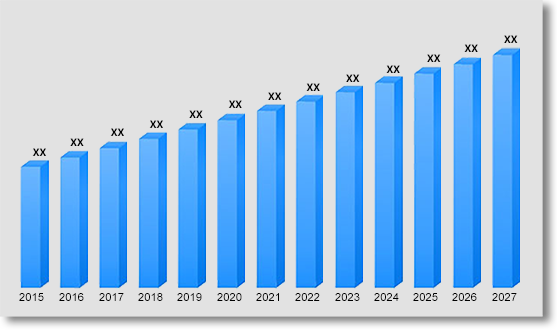
Competitive Landscape
The report provides both, qualitative and quantitative research of DACH quality management system (QMS) market, as well as provides comprehensive insights and development methods adopted by the key contenders. The report also offers extensive research on the key players in this market and details on the competitiveness of these players. Key business strategies such as mergers and acquisitions (M&A), affiliations, collaborations, and contracts adopted by these major market participants are also recognized and analysed in the report. For each company, the report studies their global presence, competitors, service offerings and specification amongst others.
Some of the players operating in the DACH quality management system (QMS) market are ABB, Aras, Babtec Informationsystem GmbH, CAQ AG Factory Systems, ConSense GmbH, COSMO CONSULT AG, Dassault Systèmes, Digimarc Corporation, Gurock, Omnex, Inc, Pickert & Partner GmbH, QDA SOLUTIONS GMBH, Quality Austria, Siemens and Software AG amongst others.
DACH Quality Management System (QMS) Market:
- By Component
- Solutions
- Services
- Professional Services
- Support & Training
- Others
- By Deployment Mode
- Cloud Based
- On Premise
- By Organization Size
- Small and Medium Sized Enterprises
- Large Enterprises
- By Industry Verticals
- Manufacturing
- IT
- Aerospace
- Automotive
- Pharmaceutical
- Medical Devices
- Food and Beverages
- Blood, Biologics and Tissue
- Dietary Supplements
- Consumer Goods
- Others
- By Country
- Germany
- Austria
- Switzerland
Table of Contents
![]()
1. Market
Scope
1.1. Market
Segmentation
1.2. Years
Considered
1.2.1. Historic
Years: 2015 - 2018
1.2.2. Base
Year: 2019
1.2.3. Forecast
Years: 2020 – 2028
2. Key Target
Audiences
3. Research
Methodology
3.1. Primary
Research
3.1.1. Research
Questionnaire
3.1.2. DACH
Percentage Breakdown
3.1.3. Primary
Interviews: Key Opinion Leaders (KOLs)
3.2. Secondary
Research
3.2.1. Paid
Databases
3.2.2. Secondary
Sources
3.3. Market
Size Estimates
3.3.1. Top-Down
Approach
3.3.2. Bottom-Up
Approach
3.4. Data
Triangulation Methodology
3.5. Research
Assumptions
4. Recommendations
and Insights from AMI’s Perspective**
5. Holistic
Overview of Quality Management System (QMS) Market
6. Market
Synopsis: Quality Management System
(QMS) Market
7. Quality
Management System (QMS) Market Analysis: Qualitative Perspective
7.1. Introduction
7.1.1. Product
Definition
7.1.2. Industry
Development
7.2. Market
Dynamics
7.2.1. Drivers
7.2.2. Restraints
7.2.3. Opportunities
7.3. Trends in
Quality Management System (QMS) Market
7.4. Market
Determinants Radar Chart
7.5. Macro-Economic
and Micro-Economic Indicators: Quality Management System (QMS) Market
7.6. Porter’s Five Force Analysis
7.7. Impact of
Covid-19 on Quality Management System (QMS) Market
8. DACH
Quality Management System (QMS) Market Analysis and Forecasts, 2020 – 2028
8.1. Overview
8.1.1. DACH
Quality Management System (QMS) Market Revenue (US$ Mn)
8.2. DACH
Quality Management System (QMS) Market Revenue (US$ Mn) and Forecasts, By Component
8.2.1. Solution
8.2.1.1. Definition
8.2.1.2. Market
Penetration, 2018
8.2.1.3. Market
Estimation, 2015 – 2019
8.2.1.4. Market
Forecast, 2020 – 2028
8.2.1.5. Compound
Annual Growth Rate (CAGR)
8.2.1.6. Regional
Bifurcation
8.2.1.6.1. Germany
8.2.1.6.1.1. Market
Estimation, 2015 – 2019
8.2.1.6.1.2. Market
Forecast, 2020 – 2028
8.2.1.6.2. Austria
8.2.1.6.2.1. Market
Estimation, 2015 – 2019
8.2.1.6.2.2. Market
Forecast, 2020 – 2028
8.2.1.6.3. Switzerland
8.2.1.6.3.1. Market
Estimation, 2015 – 2019
8.2.1.6.3.2. Market
Forecast, 2020 – 2028
8.2.2. Services
(Definition, Market Penetration (2019), Market Estimation (2015 – 2019), Market
Forecast (2020 – 2028), Compound Annual Growth Rate (CAGR), Regional
Bifurcation (Germany, Austria, Switzerland) and Information on Professional
Services, Support and Training, Others)
8.2.2.1. Professional
Services
8.2.2.2. Support
and Training
8.2.2.3. Others
8.3. Key
Segment for Channeling Investments
8.3.1. By
Component
9. DACH
Quality Management System (QMS) Market Analysis and Forecasts, 2020 – 2028
9.1. Overview
9.2. DACH
Quality Management System (QMS) Market Revenue (US$ Mn) and Forecasts, By Deployment Mode
9.2.1. Cloud
Based
9.2.1.1. Definition
9.2.1.2. Market
Penetration, 2018
9.2.1.3. Market
Estimation, 2015 – 2019
9.2.1.4. Market
Forecast, 2020 – 2028
9.2.1.5. Compound
Annual Growth Rate (CAGR)
9.2.1.6. Regional
Bifurcation
9.2.1.6.1. Germany
9.2.1.6.1.1. Market
Estimation, 2015 – 2019
9.2.1.6.1.2. Market
Forecast, 2020 – 2028
9.2.1.6.2. Austria
9.2.1.6.2.1. Market
Estimation, 2015 – 2019
9.2.1.6.2.2. Market
Forecast, 2020 – 2028
9.2.1.6.3. Switzerland
9.2.1.6.3.1. Market
Estimation, 2015 – 2019
9.2.1.6.3.2. Market
Forecast, 2020 – 2028
9.2.2. On
Premise
9.2.2.1. Definition
9.2.2.2. Market
Penetration, 2018
9.2.2.3. Market
Estimation, 2015 – 2019
9.2.2.4. Market
Forecast, 2020 – 2028
9.2.2.5. Compound
Annual Growth Rate (CAGR)
9.2.2.6. Regional
Bifurcation
9.2.2.6.1. Germany
9.2.2.6.1.1. Market
Estimation, 2015 – 2019
9.2.2.6.1.2. Market
Forecast, 2020 – 2028
9.2.2.6.2. Austria
9.2.2.6.2.1. Market
Estimation, 2015 – 2019
9.2.2.6.2.2. Market
Forecast, 2020 – 2028
9.2.2.6.3. Switzerland
9.2.2.6.3.1. Market
Estimation, 2015 – 2019
9.2.2.6.3.2. Market
Forecast, 2020 – 2028
9.3. Key
Segment for Channeling Investments
9.3.1. By
Deployment Mode
10. DACH
Quality Management System (QMS) Market Analysis and Forecasts, 2020 – 2028
10.1. Overview
10.2. DACH
Quality Management System (QMS) Market Revenue (US$ Mn) and Forecasts, By Organization Size
10.2.1. Small
and Medium Sized Enterprises
10.2.1.1. Definition
10.2.1.2. Market
Penetration, 2018
10.2.1.3. Market
Estimation, 2015 – 2019
10.2.1.4. Market
Forecast, 2020 – 2028
10.2.1.5. Compound
Annual Growth Rate (CAGR)
10.2.1.6. Regional
Bifurcation
10.2.1.6.1. Germany
10.2.1.6.1.1. Market
Estimation, 2015 – 2019
10.2.1.6.1.2. Market
Forecast, 2020 – 2028
10.2.1.6.2. Austria
10.2.1.6.2.1. Market
Estimation, 2015 – 2019
10.2.1.6.2.2. Market
Forecast, 2020 – 2028
10.2.1.6.3. Switzerland
10.2.1.6.3.1. Market
Estimation, 2015 – 2019
10.2.1.6.3.2. Market
Forecast, 2020 – 2028
10.2.2. Large
Enterprises
10.2.2.1. Definition
10.2.2.2. Market
Penetration, 2018
10.2.2.3. Market
Estimation, 2015 – 2019
10.2.2.4. Market
Forecast, 2020 – 2028
10.2.2.5. Compound
Annual Growth Rate (CAGR)
10.2.2.6. Regional
Bifurcation
10.2.2.6.1. Germany
10.2.2.6.1.1. Market
Estimation, 2015 – 2019
10.2.2.6.1.2. Market
Forecast, 2020 – 2028
10.2.2.6.2. Austria
10.2.2.6.2.1. Market
Estimation, 2015 – 2019
10.2.2.6.2.2. Market
Forecast, 2020 – 2028
10.2.2.6.3. Switzerland
10.2.2.6.3.1. Market
Estimation, 2015 – 2019
10.2.2.6.3.2. Market
Forecast, 2020 – 2028
10.3. Key
Segment for Channeling Investments
10.3.1. By
Organization Size
11. DACH
Quality Management System (QMS) Market Analysis and Forecasts, 2020 – 2028
11.1. Overview
11.2. DACH
Quality Management System (QMS) Market Revenue (US$ Mn) and Forecasts, By Industry Verticals
11.2.1. Manufacturing
11.2.1.1. Definition
11.2.1.2. Market
Penetration, 2018
11.2.1.3. Market
Estimation, 2015 – 2019
11.2.1.4. Market
Forecast, 2020 – 2028
11.2.1.5. Compound
Annual Growth Rate (CAGR)
11.2.1.6. Regional
Bifurcation
11.2.1.6.1. Germany
11.2.1.6.1.1. Market
Estimation, 2015 – 2019
11.2.1.6.1.2. Market
Forecast, 2020 – 2028
11.2.1.6.2. Austria
11.2.1.6.2.1. Market
Estimation, 2015 – 2019
11.2.1.6.2.2. Market
Forecast, 2020 – 2028
11.2.1.6.3. Switzerland
11.2.1.6.3.1. Market
Estimation, 2015 – 2019
11.2.1.6.3.2. Market
Forecast, 2020 – 2028
11.2.2. IT
11.2.2.1. Definition
11.2.2.2. Market
Penetration, 2018
11.2.2.3. Market
Estimation, 2015 – 2019
11.2.2.4. Market
Forecast, 2020 – 2028
11.2.2.5. Compound
Annual Growth Rate (CAGR)
11.2.2.6. Regional
Bifurcation
11.2.2.6.1. Germany
11.2.2.6.1.1. Market
Estimation, 2015 – 2019
11.2.2.6.1.2. Market
Forecast, 2020 – 2028
11.2.2.6.2. Austria
11.2.2.6.2.1. Market
Estimation, 2015 – 2019
11.2.2.6.2.2. Market
Forecast, 2020 – 2028
11.2.2.6.3. Switzerland
11.2.2.6.3.1. Market
Estimation, 2015 – 2019
11.2.2.6.3.2. Market
Forecast, 2020 – 2028
11.2.3. Aerospace
11.2.3.1. Definition
11.2.3.2. Market
Penetration, 2018
11.2.3.3. Market
Estimation, 2015 – 2019
11.2.3.4. Market
Forecast, 2020 – 2028
11.2.3.5. Compound
Annual Growth Rate (CAGR)
11.2.3.6. Regional
Bifurcation
11.2.3.6.1. Germany
11.2.3.6.1.1. Market
Estimation, 2015 – 2019
11.2.3.6.1.2. Market
Forecast, 2020 – 2028
11.2.3.6.2. Austria
11.2.3.6.2.1. Market
Estimation, 2015 – 2019
11.2.3.6.2.2. Market
Forecast, 2020 – 2028
11.2.3.6.3. Switzerland
11.2.3.6.3.1. Market
Estimation, 2015 – 2019
11.2.3.6.3.2. Market
Forecast, 2020 – 2028
11.2.4. Automotive
11.2.4.1. Definition
11.2.4.2. Market
Penetration, 2018
11.2.4.3. Market
Estimation, 2015 – 2019
11.2.4.4. Market
Forecast, 2020 – 2028
11.2.4.5. Compound
Annual Growth Rate (CAGR)
11.2.4.6. Regional
Bifurcation
11.2.4.6.1. Germany
11.2.4.6.1.1. Market
Estimation, 2015 – 2019
11.2.4.6.1.2. Market
Forecast, 2020 – 2028
11.2.4.6.2. Austria
11.2.4.6.2.1. Market
Estimation, 2015 – 2019
11.2.4.6.2.2. Market
Forecast, 2020 – 2028
11.2.4.6.3. Switzerland
11.2.4.6.3.1. Market
Estimation, 2015 – 2019
11.2.4.6.3.2. Market
Forecast, 2020 – 2028
11.2.5. Pharmaceutical
11.2.5.1. Definition
11.2.5.2. Market
Penetration, 2018
11.2.5.3. Market
Estimation, 2015 – 2019
11.2.5.4. Market
Forecast, 2020 – 2028
11.2.5.5. Compound
Annual Growth Rate (CAGR)
11.2.5.6. Regional
Bifurcation
11.2.5.6.1. Germany
11.2.5.6.1.1. Market
Estimation, 2015 – 2019
11.2.5.6.1.2. Market
Forecast, 2020 – 2028
11.2.5.6.2. Austria
11.2.5.6.2.1. Market
Estimation, 2015 – 2019
11.2.5.6.2.2. Market
Forecast, 2020 – 2028
11.2.5.6.3. Switzerland
11.2.5.6.3.1. Market
Estimation, 2015 – 2019
11.2.5.6.3.2. Market
Forecast, 2020 – 2028
11.2.6. Medical
Devices
11.2.6.1. Definition
11.2.6.2. Market
Penetration, 2018
11.2.6.3. Market
Estimation, 2015 – 2019
11.2.6.4. Market
Forecast, 2020 – 2028
11.2.6.5. Compound
Annual Growth Rate (CAGR)
11.2.6.6. Regional
Bifurcation
11.2.6.6.1. Germany
11.2.6.6.1.1. Market
Estimation, 2015 – 2019
11.2.6.6.1.2. Market
Forecast, 2020 – 2028
11.2.6.6.2. Austria
11.2.6.6.2.1. Market
Estimation, 2015 – 2019
11.2.6.6.2.2. Market
Forecast, 2020 – 2028
11.2.6.6.3. Switzerland
11.2.6.6.3.1. Market
Estimation, 2015 – 2019
11.2.6.6.3.2. Market
Forecast, 2020 – 2028
11.2.7. Food
and Beverages
11.2.7.1. Definition
11.2.7.2. Market
Penetration, 2018
11.2.7.3. Market
Estimation, 2015 – 2019
11.2.7.4. Market
Forecast, 2020 – 2028
11.2.7.5. Compound
Annual Growth Rate (CAGR)
11.2.7.6. Regional
Bifurcation
11.2.7.6.1. Germany
11.2.7.6.1.1. Market
Estimation, 2015 – 2019
11.2.7.6.1.2. Market
Forecast, 2020 – 2028
11.2.7.6.2. Austria
11.2.7.6.2.1. Market
Estimation, 2015 – 2019
11.2.7.6.2.2. Market
Forecast, 2020 – 2028
11.2.7.6.3. Switzerland
11.2.7.6.3.1. Market
Estimation, 2015 – 2019
11.2.7.6.3.2. Market
Forecast, 2020 – 2028
11.2.8. Blood,
Biologics and Tissue
11.2.8.1. Definition
11.2.8.2. Market
Penetration, 2018
11.2.8.3. Market
Estimation, 2015 – 2019
11.2.8.4. Market
Forecast, 2020 – 2028
11.2.8.5. Compound
Annual Growth Rate (CAGR)
11.2.8.6. Regional
Bifurcation
11.2.8.6.1. Germany
11.2.8.6.1.1. Market
Estimation, 2015 – 2019
11.2.8.6.1.2. Market
Forecast, 2020 – 2028
11.2.8.6.2. Austria
11.2.8.6.2.1. Market
Estimation, 2015 – 2019
11.2.8.6.2.2. Market
Forecast, 2020 – 2028
11.2.8.6.3. Switzerland
11.2.8.6.3.1. Market
Estimation, 2015 – 2019
11.2.8.6.3.2. Market
Forecast, 2020 – 2028
11.2.9. Dietary
Supplements
11.2.9.1. Definition
11.2.9.2. Market
Penetration, 2018
11.2.9.3. Market
Estimation, 2015 – 2019
11.2.9.4. Market
Forecast, 2020 – 2028
11.2.9.5. Compound
Annual Growth Rate (CAGR)
11.2.9.6. Regional
Bifurcation
11.2.9.6.1. Germany
11.2.9.6.1.1. Market
Estimation, 2015 – 2019
11.2.9.6.1.2. Market
Forecast, 2020 – 2028
11.2.9.6.2. Austria
11.2.9.6.2.1. Market
Estimation, 2015 – 2019
11.2.9.6.2.2. Market
Forecast, 2020 – 2028
11.2.9.6.3. Switzerland
11.2.9.6.3.1. Market
Estimation, 2015 – 2019
11.2.9.6.3.2. Market
Forecast, 2020 – 2028
11.2.10. Consumer
Goods
11.2.10.1. Definition
11.2.10.2. Market
Penetration, 2018
11.2.10.3. Market
Estimation, 2015 – 2019
11.2.10.4. Market
Forecast, 2020 – 2028
11.2.10.5. Compound
Annual Growth Rate (CAGR)
11.2.10.6. Regional
Bifurcation
11.2.10.6.1. Germany
11.2.10.6.1.1. Market
Estimation, 2015 – 2019
11.2.10.6.1.2. Market
Forecast, 2020 – 2028
11.2.10.6.2. Austria
11.2.10.6.2.1. Market
Estimation, 2015 – 2019
11.2.10.6.2.2. Market
Forecast, 2020 – 2028
11.2.10.6.3. Switzerland
11.2.10.6.3.1. Market
Estimation, 2015 – 2019
11.2.10.6.3.2. Market
Forecast, 2020 – 2028
11.2.11. Others
11.2.11.1. Definition
11.2.11.2. Market
Penetration, 2018
11.2.11.3. Market
Estimation, 2015 – 2019
11.2.11.4. Market
Forecast, 2020 – 2028
11.2.11.5. Compound
Annual Growth Rate (CAGR)
11.2.11.6. Regional
Bifurcation
11.2.11.6.1. Germany
11.2.11.6.1.1. Market
Estimation, 2015 – 2019
11.2.11.6.1.2. Market
Forecast, 2020 – 2028
11.2.11.6.2. Austria
11.2.11.6.2.1. Market
Estimation, 2015 – 2019
11.2.11.6.2.2. Market
Forecast, 2020 – 2028
11.2.11.6.3. Switzerland
11.2.11.6.3.1. Market
Estimation, 2015 – 2019
11.2.11.6.3.2. Market
Forecast, 2020 – 2028
11.3. Key
Segment for Channeling Investments
11.3.1. By
Industry Verticals
12. DACH
Quality Management System (QMS) Market Analysis and Forecasts, 2020 – 2028
12.1. Overview
12.2. DACH
Quality Management System (QMS) Market Revenue (US$ Mn) and Forecasts By
Country
12.2.1. Germany
12.2.1.1. Germany
Quality Management System (QMS) Market Revenue (US$ Mn) and Forecasts, By
Component
12.2.1.1.1. Solution
12.2.1.1.2. Services
12.2.1.1.2.1. Professional
Services
12.2.1.1.2.2. Support
and Training
12.2.1.1.2.3. Others
12.2.1.2. Germany
Quality Management System (QMS) Market Revenue (US$ Mn) and Forecasts, By
Deployment Mode
12.2.1.2.1. Cloud
Based
12.2.1.2.2. On
Premise
12.2.1.3. Germany
Quality Management System (QMS) Market Revenue (US$ Mn) and Forecasts, By
Organization Size
12.2.1.3.1. Small
and Medium Sized Enterprises
12.2.1.3.2. Large
Enterprises
12.2.1.4. Germany
Quality Management System (QMS) Market Revenue (US$ Mn) and Forecasts, By
Industry Verticals
12.2.1.4.1. Manufacturing
12.2.1.4.2. IT
12.2.1.4.3. Aerospace
12.2.1.4.4. Automotive
12.2.1.4.5. Pharmaceutical
12.2.1.4.6. Medical
Devices
12.2.1.4.7. Food
and Beverages
12.2.1.4.8. Blood,
Biologics and Tissue
12.2.1.4.9. Dietary
Supplements
12.2.1.4.10. Consumer
Goods
12.2.1.4.11. Others
12.2.2. Austria
12.2.2.1. Austria
Quality Management System (QMS) Market Revenue (US$ Mn) and Forecasts, By
Component
12.2.2.1.1. Solution
12.2.2.1.2. Services
12.2.2.1.2.1. Professional
Services
12.2.2.1.2.2. Support
and Training
12.2.2.1.2.3. Others
12.2.2.2. Austria
Quality Management System (QMS) Market Revenue (US$ Mn) and Forecasts, By
Deployment Mode
12.2.2.2.1. Cloud
Based
12.2.2.2.2. On
Premise
12.2.2.3. Austria
Quality Management System (QMS) Market Revenue (US$ Mn) and Forecasts, By
Organization Size
12.2.2.3.1. Small
and Medium Sized Enterprises
12.2.2.3.2. Large
Enterprises
12.2.2.4. Austria
Quality Management System (QMS) Market Revenue (US$ Mn) and Forecasts, By
Industry Verticals
12.2.2.4.1. Manufacturing
12.2.2.4.2. IT
12.2.2.4.3. Aerospace
12.2.2.4.4. Automotive
12.2.2.4.5. Pharmaceutical
12.2.2.4.6. Medical
Devices
12.2.2.4.7. Food
and Beverages
12.2.2.4.8. Blood,
Biologics and Tissue
12.2.2.4.9. Dietary
Supplements
12.2.2.4.10. Consumer
Goods
12.2.2.4.11. Others
12.2.3. Switzerland
12.2.3.1. Switzerland
Quality Management System (QMS) Market Revenue (US$ Mn) and Forecasts, By
Component
12.2.3.1.1. Solution
12.2.3.1.2. Services
12.2.3.1.2.1. Professional
Services
12.2.3.1.2.2. Support
and Training
12.2.3.1.2.3. Others
12.2.3.2. Switzerland
Quality Management System (QMS) Market Revenue (US$ Mn) and Forecasts, By
Deployment Mode
12.2.3.2.1. Cloud
Based
12.2.3.2.2. On
Premise
12.2.3.3. Switzerland
Quality Management System (QMS) Market Revenue (US$ Mn) and Forecasts, By
Organization Size
12.2.3.3.1. Small
and Medium Sized Enterprises
12.2.3.3.2. Large
Enterprises
12.2.3.4. Switzerland
Quality Management System (QMS) Market Revenue (US$ Mn) and Forecasts, By
Industry Verticals
12.2.3.4.1. Manufacturing
12.2.3.4.2. IT
12.2.3.4.3. Aerospace
12.2.3.4.4. Automotive
12.2.3.4.5. Pharmaceutical
12.2.3.4.6. Medical
Devices
12.2.3.4.7. Food
and Beverages
12.2.3.4.8. Blood,
Biologics and Tissue
12.2.3.4.9. Dietary
Supplements
12.2.3.4.10. Consumer
Goods
12.2.3.4.11. Others
13. Competitive
Benchmarking
13.1. Market
Share Analysis, 2019
13.2. DACH
Presence and Growth Strategies
13.2.1. Mergers
and Acquisitions
13.2.2. Product
Launches
13.2.3. Investments
Trends
13.2.4. R&D
Initiatives
14. Player
Profiles
14.1. ABB
14.1.1. Company
Details
14.1.2. Company
Overview
14.1.3. Product
Offerings
14.1.4. Key
Developments
14.1.5. Financial
Analysis
14.1.6. SWOT
Analysis
14.1.7. Business
Strategies
14.2. Aras
14.2.1. Company
Details
14.2.2. Company
Overview
14.2.3. Product
Offerings
14.2.4. Key
Developments
14.2.5. Financial
Analysis
14.2.6. SWOT
Analysis
14.2.7. Business
Strategies
14.3. Babtec
Informationsystem GmbH
14.3.1. Company
Details
14.3.2. Company
Overview
14.3.3. Product
Offerings
14.3.4. Key
Developments
14.3.5. Financial
Analysis
14.3.6. SWOT
Analysis
14.3.7. Business
Strategies
14.4. CAQ AG
Factory Systems
14.4.1. Company
Details
14.4.2. Company
Overview
14.4.3. Product
Offerings
14.4.4. Key
Developments
14.4.5. Financial
Analysis
14.4.6. SWOT
Analysis
14.4.7. Business
Strategies
14.5. ConSense
GmbH
14.5.1. Company
Details
14.5.2. Company
Overview
14.5.3. Product
Offerings
14.5.4. Key
Developments
14.5.5. Financial
Analysis
14.5.6. SWOT
Analysis
14.5.7. Business
Strategies
14.6. COSMO
CONSULT AG
14.6.1. Company
Details
14.6.2. Company
Overview
14.6.3. Product
Offerings
14.6.4. Key
Developments
14.6.5. Financial
Analysis
14.6.6. SWOT
Analysis
14.6.7. Business
Strategies
14.7. Dassault
Systèmes
14.7.1. Company
Details
14.7.2. Company
Overview
14.7.3. Product
Offerings
14.7.4. Key
Developments
14.7.5. Financial
Analysis
14.7.6. SWOT
Analysis
14.7.7. Business
Strategies
14.8. Digimarc
Corporation
14.8.1. Company
Details
14.8.2. Company
Overview
14.8.3. Product
Offerings
14.8.4. Key
Developments
14.8.5. Financial
Analysis
14.8.6. SWOT
Analysis
14.8.7. Business
Strategies
14.9. Gurock
14.9.1. Company
Details
14.9.2. Company
Overview
14.9.3. Product
Offerings
14.9.4. Key
Developments
14.9.5. Financial
Analysis
14.9.6. SWOT
Analysis
14.9.7. Business
Strategies
14.10. Omnex,
Inc
14.10.1. Company
Details
14.10.2. Company
Overview
14.10.3. Product
Offerings
14.10.4. Key
Developments
14.10.5. Financial
Analysis
14.10.6. SWOT
Analysis
14.10.7. Business
Strategies
14.11. Pickert
& Partner GmbH
14.11.1. Company
Details
14.11.2. Company
Overview
14.11.3. Product
Offerings
14.11.4. Key
Developments
14.11.5. Financial
Analysis
14.11.6. SWOT
Analysis
14.11.7. Business
Strategies
14.12. QDA
SOLUTIONS GMBH
14.12.1. Company
Details
14.12.2. Company
Overview
14.12.3. Product
Offerings
14.12.4. Key
Developments
14.12.5. Financial
Analysis
14.12.6. SWOT
Analysis
14.12.7. Business
Strategies
14.13. Quality
Austria
14.13.1. Company
Details
14.13.2. Company
Overview
14.13.3. Product
Offerings
14.13.4. Key
Developments
14.13.5. Financial
Analysis
14.13.6. SWOT
Analysis
14.13.7. Business
Strategies
14.14. Siemens
14.14.1. Company
Details
14.14.2. Company
Overview
14.14.3. Product
Offerings
14.14.4. Key
Developments
14.14.5. Financial
Analysis
14.14.6. SWOT
Analysis
14.14.7. Business
Strategies
14.15. Software
AG
14.15.1. Company
Details
14.15.2. Company
Overview
14.15.3. Product
Offerings
14.15.4. Key
Developments
14.15.5. Financial
Analysis
14.15.6. SWOT
Analysis
14.15.7. Business Strategies
14.16. Other
Industry Participants
15. Key Findings
Note: This ToC is tentative
and can be changed according to the research study conducted during the course
of report completion.
**Exclusive for Multi-User and Enterprise User
At Absolute Markets Insights, we are engaged in building both global as well as country specific reports. As a result, the approach taken for deriving the estimation and forecast for a specific country is a bit unique and different in comparison to the global research studies. In this case, we not only study the concerned market factors & trends prevailing in a particular country (from secondary research) but we also tend to calculate the actual market size & forecast from the revenue generated from the market participants involved in manufacturing or distributing the any concerned product. These companies can also be service providers. For analyzing any country specifically, we do consider the growth factors prevailing under the states/cities/county for the same. For instance, if we are analyzing an industry specific to United States, we primarily need to study about the states present under the same(where the product/service has the highest growth). Similar analysis will be followed by other countries. Our scope of the report changes with different markets.
Our research study is mainly implement through a mix of both secondary and primary research. Various sources such as industry magazines, trade journals, and government websites and trade associations are reviewed for gathering precise data. Primary interviews are conducted to validate the market size derived from secondary research. Industry experts, major manufacturers and distributors are contacted for further validation purpose on the current market penetration and growth trends.
Prominent participants in our primary research process include:
- Key Opinion Leaders namely the CEOs, CSOs, VPs, purchasing managers, amongst others
- Research and development participants, distributors/suppliers and subject matter experts
Secondary Research includes data extracted from paid data sources:
- Reuters
- Factiva
- Bloomberg
- One Source
- Hoovers
Research Methodology
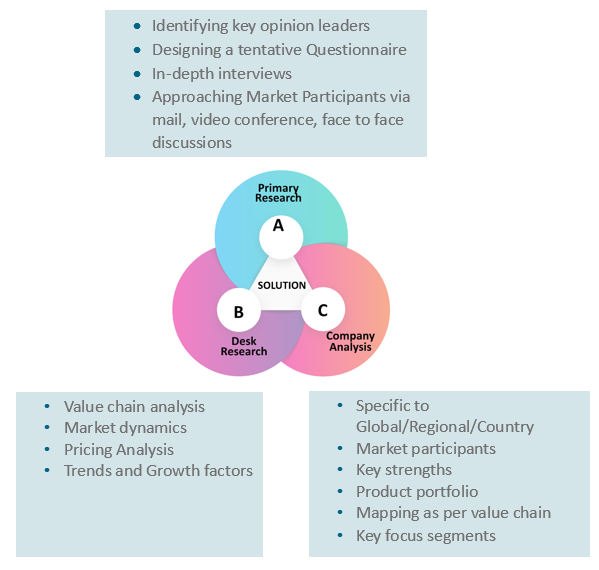
Key Inclusions
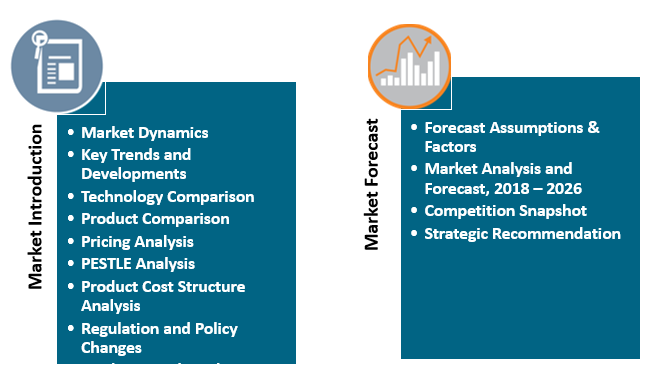
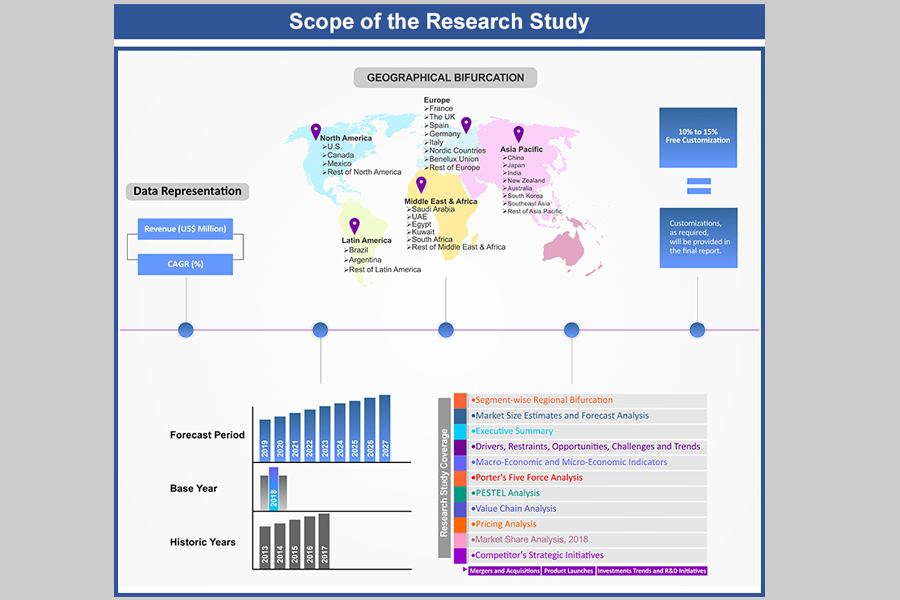
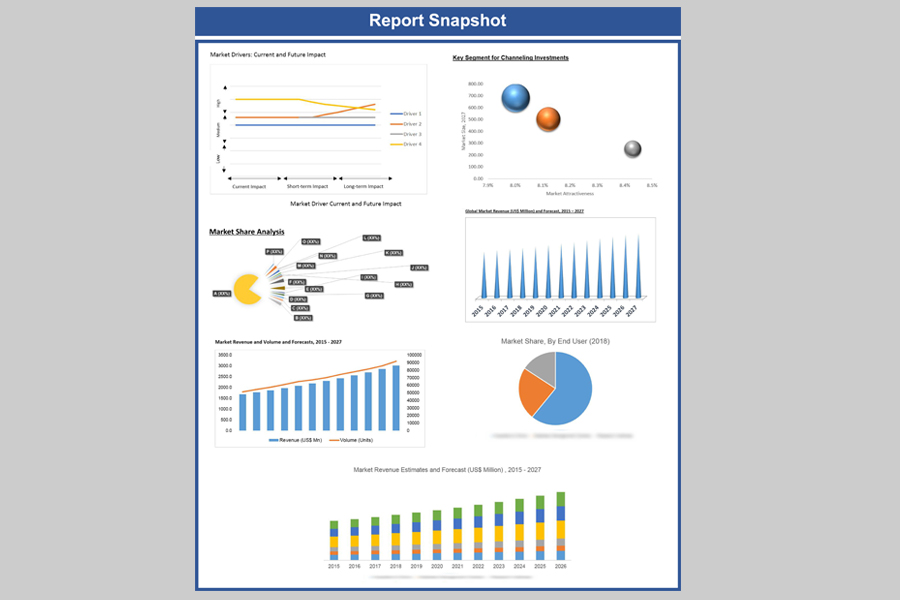
Why Absolute Markets Insights?
An effective strategy is the entity that influences a business to stand out of the crowd. An organization with a phenomenal strategy for success dependably has the edge over the rivals in the market. It offers the organizations a head start in planning their strategy. Absolute Market Insights is the new initiation in the industry that will furnish you with the lead your business needs. Absolute Market Insights is the best destination for your business intelligence and analytical solutions; essentially because our qualitative and quantitative sources of information are competent to give one-stop solutions. We inventively combine qualitative and quantitative research in accurate proportions to have the best report, which not only gives the most recent insights but also assists you to grow.

